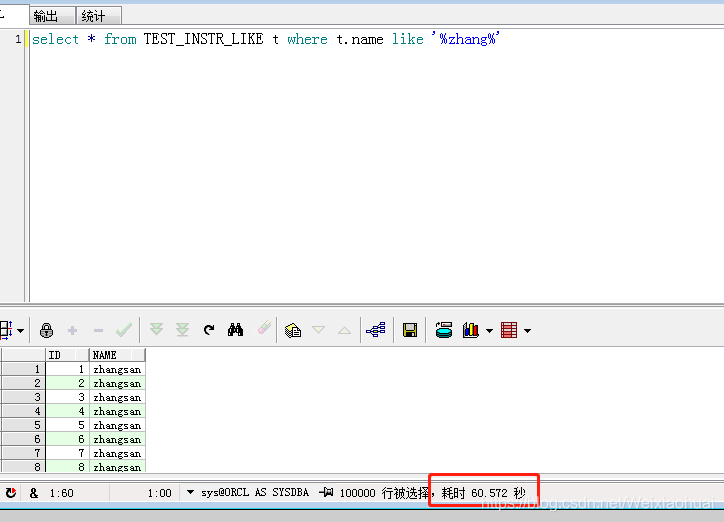Oracle中可以代替like進行模糊查詢的方法instr(更高效)
一、簡介
相信大家都使用過like進行模糊匹配查詢,在oracle中,instr()方法可以用來代替like進行模糊查詢,大資料量的時候效率更高。本文將對instr()的基本使用方法進行詳解以及通過示例講解與like的效率對比。
二、使用說明
instr(sourceString,destString,start,appearPosition)
對應引數描述: instr('源字串' , '目標字串' ,'開始位置','第幾次出現'),返回目標字串在源字串中的位置。後面兩個引數可要可不要。
下面,我們以一些示例講解使用方法:
【a】從開頭開始查詢第一個‘h’出現的位置
--從開頭開始查詢第一個‘h’出現的位置
select instr('zhangsan', 'h') as idx from dual; --2
查詢結果:

【b】從開頭開始查詢‘an’在字串中的位置
--從開頭開始查詢‘an’在字串中的位置
select instr('zhangsan','an') idx from dual; --3查詢結果:

【c】從第一個位置開始查詢,返回第二次出現‘a’的位置
--從第一個位置開始查詢,返回第二次出現‘a’的位置 select instr('zhangsan','a',1,'2') idx from dual; --7
查詢結果:

【d】從倒數第一個位置開始,查詢第一次出現‘a’的位置
--從倒數第一個位置開始,查詢第一次出現‘a’的位置
select instr('zhangsan','a',-1,1) idx from dual; --7查詢結果:

【e】從倒數第一個位置開始,返回第二次出現‘a’的位置
--從倒數第一個位置開始,返回第二次出現‘a’的位置
select instr('zhangsan','a',-1,2) idx from dual; --3查詢結果:

三、instr()與like比較
instr函式也有三種情況:
a. instr(欄位,'關鍵字') > 0 相當於 欄位like '%關鍵字%': 表示在字串中包含‘關鍵字’
b. instr(欄位,'關鍵字') = 1 相當於 欄位like '關鍵字%' 表示以‘關鍵字’開頭的字串
c. instr(欄位,'關鍵字') = 0 相當於 欄位not like '%關鍵字%' 表示在字串中不包含‘關鍵字’
下面通過一個示例說明like 與 instr()的使用比較:
【a】使用like進行模糊查詢
with temp1 as (
select 'zhangsan' as name from dual),
temp2 as (
select 'zhangsi' as name from dual),
temp3 as (
select 'xiaoming' as name from dual),
temp4 as (
select 'xiaohong' as name from dual),
temp5 as (
select 'zhaoliu' as name from dual)
select * from (select * from temp1
union all
select * from temp2
union all
select * from temp3
union all
select * from temp4
union all
select * from temp5) res where res.name like '%zhang%'查詢字串中包含‘zhang’的結果:

【b】使用instr()進行模糊查詢
(1) 查詢字串中包含‘zhang’的結果:
with temp1 as (
select 'zhangsan' as name from dual),
temp2 as (
select 'zhangsi' as name from dual),
temp3 as (
select 'xiaoming' as name from dual),
temp4 as (
select 'xiaohong' as name from dual),
temp5 as (
select 'zhaoliu' as name from dual)
select * from (select * from temp1
union all
select * from temp2
union all
select * from temp3
union all
select * from temp4
union all
select * from temp5) res where instr(res.name,'zhang') > 0;
(2) 查詢字串中不包含‘zhang’的結果:
with temp1 as (
select 'zhangsan' as name from dual),
temp2 as (
select 'zhangsi' as name from dual),
temp3 as (
select 'xiaoming' as name from dual),
temp4 as (
select 'xiaohong' as name from dual),
temp5 as (
select 'zhaoliu' as name from dual)
select * from (select * from temp1
union all
select * from temp2
union all
select * from temp3
union all
select * from temp4
union all
select * from temp5) res where instr(res.name,'zhang') = 0;
(3) 查詢以‘zhang’開頭的字串:
with temp1 as (
select 'zhangsan' as name from dual),
temp2 as (
select 'zhangsi' as name from dual),
temp3 as (
select 'sizhangsan' as name from dual),
temp4 as (
select 'xiaohong' as name from dual),
temp5 as (
select 'zhaoliu' as name from dual)
select * from (select * from temp1
union all
select * from temp2
union all
select * from temp3
union all
select * from temp4
union all
select * from temp5) res where instr(res.name,'zhang') = 1;
(4)instr與like特殊用法
select id, name from users where instr('a, b', id) > 0;
--等價於
select id, name
from users
where id = a
or id = b;
--等價於
select id, name from users where id in (a, b);四、效率對比
【a】使用plsql建立一張十萬條資料測試資料表,同時為需要進行模糊查詢的列增加索引
--建立10萬條測試資料
create table test_instr_like as
select rownum as id,'zhangsan' as name
from dual
connect by level <= 100000;
--name列建立索引
create index idx_tb_name on test_instr_like(name);【b】使用like進行模糊查詢
select * from TEST_INSTR_LIKE t where t.name like '%zhang%'
總耗時: 60秒

【c】使用instr進行模糊查詢
select * from TEST_INSTR_LIKE t where instr(t.name, 'zhang') > 0;
總耗時:50秒

由圖可見,instr查詢的速度確實比like快一些,但是,看執行計劃的話,instr卻比like耗時一點。如下圖:


五、總結
以上是對instr基本使用方法的講解以及通過示例對比了like與instr的效率,在進行模糊查詢的時候,能用instr的話就儘量用instr,畢竟資料量大的時候還是有一點優勢的,本文是筆者對like以及instr的一些總結和見解,僅供大家學習參考,共同學習,共同進步!
